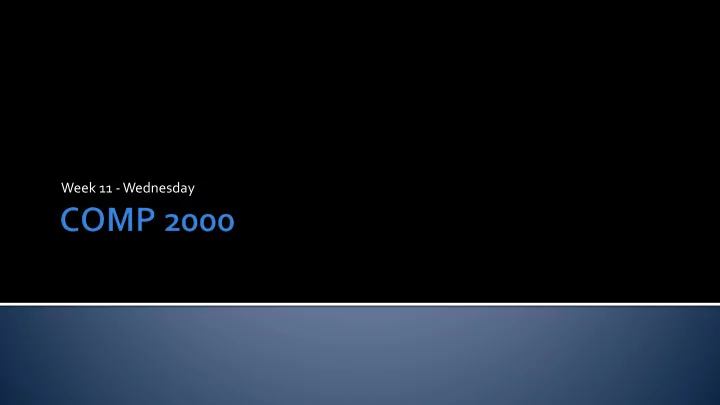

Week 11 -Wednesday
What did we talk about last time? Exam 2 Before that: Review Before that: Networking
What if you want to hold a lot of int values, or String values, or Wombat values? You make an array! But arrays have a fixed size What if you don't know how long to make it? You have to overestimate how many values you need Or you have to periodically resize your array
Another approach is using a dynamic data structure A dynamic data structure grows as you need space Python has lists (and sets and dictionaries) built in But Java depends on libraries Before we do libraries, let's implement a linked list ourselves to see what a pain it is Making data structures that work efficiently in different circumstances is the heart of COMP 2100
A linked list is one of the simplest kinds of dynamic data structures You can imagine a linked list as a train Each node in the linked list has some cargo, and it can point at the next item in the list The last item points at null so that you know that the train has ended You can add and remove nodes as much as you want, and nothing needs to be resized
The most common library implementation of a linked list is a doubly linked list Node consists of data, a next pointer, and a previous pointer Because we know the next and the previous, we can move forwards or backwards in the list X head 23 47 58 X tail
Let's try a simple definition for a doubly linked list that holds an unlimited number of String values: public class LinkedList { private static class Node { public String data; public Node next; public Node previous; } private Node head = null private Node tail = null; private int size = 0; … }
Inside the LinkedList class, we have to write methods to manipulate it There will be simple accessor methods like size() that return the size There will be simple mutator methods like clear() that remove all the elements from the list But the hard work will be methods to get, add, remove, and find elements
If we always keep the size member correctly updated, the size() accessor has a straightforward implementation public int size() { return size; } Likewise, clearing the list returns it to its state right after construction public void clear() { head = null; tail = null; size = 0; }
Method signature: public void add(String value) The method creates a new node If the list is empty, it points head at the new node Otherwise, it points the tail node's next at the new node and the new node's previous at the tail node It updates the tail to point at the new node It increases size by one
Method signature: public String get(int index) If index is illegal, throw an IndexOutOfBoundsException Loop through the list until reaching the node at location index (using 0-based indexing, because we are computer scientists!) Return the data of the node in question
Method signature: public String remove() If the list is empty, throw a NoSuchElementException Point a temporary variable at the head node Point head at the next node If the next node is null, point tail at null Otherwise, point the next node's previous at null Return the data of the temporary node
Method signature: public int indexOf(String value) Loop through the list until reaching a node whose data is equal to value , keeping a counter of the current index If value is found, return the index If value is never found, return -1
Generics
Finish Project 3 Due Friday by midnight! Read Chapter 18
Recommend
More recommend